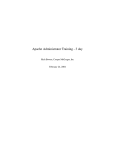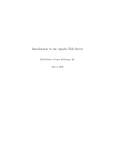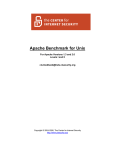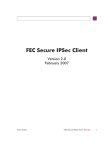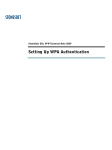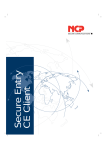Download Webcullis User Manual April 2006
Transcript
WebcullisTM User Manual April 2006 Orion Security Solutions, Inc. 1 Contents 1 Introduction 1.1 Overview . . . . . . . . . . . . . . . . . . . . . . . . . . . . . . . . 3 3 2 Installation 2.1 The Configuration File . . 2.2 Trust Anchor Management 2.3 The ISAPI Filter . . . . . 2.4 De-installation . . . . . . . 3 4 . . . . . . . . . . . . . . . . . . . . . . . . . . . . . . . . . . . . . . . . . . . . . . . . . . . . . . . . . . . . . . . . . . . . . . . . 3 4 4 4 7 Configuration Options 3.1 General Configuration Options . . . . 3.1.1 TrustRootPath . . . . . . . . 3.1.2 CacheEntries . . . . . . . . . 3.1.3 MaxCacheAge . . . . . . . . 3.1.4 LogLevel . . . . . . . . . . . 3.1.5 LogPath . . . . . . . . . . . . 3.1.6 TracePath . . . . . . . . . . . 3.1.7 ErrorDocument . . . . . . . . 3.2 Directory-Level Configuration Options 3.2.1 LDAPRepository . . . . . . . 3.2.2 LocalOCSPURL . . . . . . . 3.2.3 RequireRecentCRL . . . . . . 3.2.4 CRLFreshness . . . . . . . . 3.2.5 RequireFreshCRL . . . . . . 3.2.6 AllowedPolicy . . . . . . . . 3.2.7 RequireAllPolicies . . . . . . 3.2.8 InitialExplicitPolicy . . . . . 3.2.9 InitialInhibitAnyPolicy . . . . 3.2.10 PolicyMapInhibit . . . . . . . 3.2.11 ExtendedKeyUsage . . . . . . 3.2.12 RequireMatchAllEKU . . . . 3.2.13 PermittedSubtree . . . . . . . 3.2.14 ExcludedSubtree . . . . . . . 3.2.15 MinKeySize . . . . . . . . . . . . . . . . . . . . . . . . . . . . . . . . . . . . . . . . . . . . . . . . . . . . . . . . . . . . . . . . . . . . . . . . . . . . . . . . . . . . . . . . . . . . . . . . . . . . . . . . . . . . . . . . . . . . . . . . . . . . . . . . . . . . . . . . . . . . . . . . . . . . . . . . . . . . . . . . . . . . . . . . . . . . . . . . . . . . . . . . . . . . . . . . . . . . . . . . . . . . . . . . . . . . . . . . . . . . . . . . . . . . . . . . . . . . . . . . . . . . . . . . . . . . . . . . . . . . . . . . . . . . . . . . . . . . . . . . . . . . . . . . . . . . . . . . . . . . . . . . . . . . . . . . . . . . . . . . . . . . . . . . . . . . . . . . . . . . . . . . . . . . . . . . . . . . . . . . . . . . . . . . . . . . . . . . . . . . . . . . . . . . . . . . . . . . . . . . . . . . . . . . . . . . . . . . . 7 8 8 8 8 9 9 9 9 9 10 11 11 11 11 11 12 12 12 12 12 12 12 13 13 Configuration File Examples 4.1 General Options: The Configuration File Header . . 4.2 Directory Options: The Configuration File Body . . . 4.3 Configuration Scenarios . . . . . . . . . . . . . . . . 4.3.1 Restricting access to a particular department . 4.3.2 Restricting access to particular individuals . . 4.3.3 Excluding Low-Assurance certificates . . . . 4.3.4 Excluding inappropriately used keys . . . . . 4.3.5 Key Size Restriction . . . . . . . . . . . . . . . . . . . . . . . . . . . . . . . . . . . . . . . . . . . . . . . . . . . . . . . . . . . . . . . . . . . . . . . . . . . . . . . . . . . . . 13 13 14 15 15 15 16 17 18 . . . . . . . . . . . . . . . . 2 . . . . 4.3.6 5 Prohibit test certificates from being used in production . . . . For More Information 19 19 3 1 Introduction WebcullisTM1 is a security plug-in for Microsoft’s Internet Information Services (IIS) web server. It is designed to strengthen the web server’s ability to limit access to files based on certificate policy or name constraints when the server implements X.509 PKIbased authorization schemes. 1.1 Overview The heart of the Webcullis plug-in is its configuration file, which must be written according to the authorization policies of the web server in which it is being installed. The Webcullis installation includes a sample configuration file which may be useful in this writing. Webcullis access constraints are implemented on a per-directory basis and managed in this configuration file as described in Sections 3 and 4. We recommend that administrators read carefully the options for configuration before writing their configuration file, as improper access policies can lead to the compromise of otherwise secure systems. In this document, we will first outline the procedure for installation of the Webcullis plug-in on a machine running IIS (Section 2). Next we will consider the options available for the configuration of Webcullis, including general options as well as those for per-directory access control (Section 3). Finally, we will consider excerpts of example configuration files to better illustrate the capabilities of Webcullis (Section 4), and conclude with information on resources for administrators using Webcullis (Section 5). 2 Installation To perform the installation with the Webcullis installer, complete the following steps, which are outlined in more detail in the rest of this section. This instructions assume that IIS has been installed and is configured to accept ISAPI filter plug-ins. 1. Run the Webcullis installer. 2. Write a configuration file. 3. Import trust anchors into the trustroot directory. 4. Configure ISAPI Filter for IIS. 5. Restart the web server. 2.1 The Configuration File The sample configuration file provided with Webcullis can serve as a starting point in writing a custom version. See also Section 3 for more information on the options available for use in this file, and Section 4 for sample configuration files. 1 WebcullisTM is a trademark of Orion Security Solutions, all rights reserved. All other trademarks and registered trademarks are the property of their respective owners. Unless stated to the contrary, no association with any other company or product is intended or should be inferred. 4 2.2 Trust Anchor Management Webcullis maintains its own store of trusted root CA certificates distinct from those in the Windows CAPI store. These trust anchors are added or removed by copying them to or deleting them from the trustroot directory, which is identified in the configuration file. The contents of the directory are read every time Webcullis is restarted; it is recommended that all instances of IIS be restarted if modifications to this directory are made. Because improper configuration of Webcullis or incorrect file permissions on the trustroot directory could open the web server to unauthorized access, we recommend that the administrator in charge of the web server on which Webcullis is to be installed first consult resources such as the National Security Agency’s “Guide to the Secure Configuration of Microsoft Internet and Information Services” (Section 5). We note also that the Webcullis plug-in only needs read access to the files in the trustroots directory, and recommend that administrators apply permissions to those files accordingly. 2.3 The ISAPI Filter The Webcullis installer will include an ISAPI filter DLL, which is made available to IIS using the IIS Administration MMC snap-in. Follow these steps to configure IIS 5.0 to use the filter. • From the start menu, choose Programs > Administrative tools > IIS.msc • Within the tree window to the left, expand the Internet Information Services node to view the server machine name. Select this machine name. • Within the main window, identify the web server on which you would like to run Webcullis. Right click on the server name and choose properties. 5 • Choose the ISAPI Filters tab. • Press the Add button. In the window that appears, enter a name to identify the plug-in, such as “Webcullis.” 6 • Press the browse button and navigate to the location of the Webcullis installation. Choose the file wspac_isapi.dll and press Open. • Press OK in the Filter Properties window. • Press OK in the properties window of the web server. • To start using the Webcullis plug-in, restart the web server. This is accomplished by right-clicking on the server name in the main body of the window and choosing Stop, then Start. • Verify that Webcullis is running by again right-clicking on the web server, choosing properties, and clicking on the ISAPI Filters tab. To the left of the Webcullis filter name there should be a green arrow indicating that it is running. 7 2.4 De-installation To de-install Webcullis, you should first remove it from IIS. This is accomplished by at first following the instructions of Section 2.3 on how to configure it as an ISAPI filter. However, where the directions instruct you to add the new filter, you should instead select the Webcullis filter and remove it. For your changes to take effect, you should restart all web servers that were using Webcullis for access control. Once Webcullis is no longer running, you can safely remove the software itself from your computer. 3 Configuration Options The options used in the Webcullis configuration file can be broken into two broad categories: those that affect the Webcullis program as a whole, and those that affect the way in which authorization is decided for a given directory tree (for example, the set of directories and files rooted at /reports/fy2000). Note that options of the second category– those that enforce authorization policies on a given directory– can also be specified as general options in the configuration file header. Restrictions on a directory will be executed in the following order: Specific (defined in an individual directory block of the configuration file), General (specified in the header block of the configuration file) and Default (no value is specified, and 8 the default Webcullis value is used). Note also that specifying a general authorization option in the header has a different effect than specifying one for the root directory, which is discussed in Section 3.2. Options are generally specified in the configuration file in the following format: RequireRecentCRL = Yes where the left hand side of the equation is the option key and the right had side is the value that the administrator would like implemented for this option. In this example, the administrator has decided to require a recent Certificate Revocation List while building a validation path for certificates presented for authorization to the given directory tree. Note that values of yes, Yes, and YES will be treated equally, whereas any other value to binary options will be treated as No. See Section 4 for more information on configuration file formatting. 3.1 General Configuration Options The following table outlines the Webcullis general configuration options: Option Key TrustRootPath CacheEntries MaxCacheAge LogLevel LogPath TracePath ErrorDocument 3.1.1 Valid Value(s) Directory 0-2147483647 0-2147483647 (seconds) Log level Log file Log file for trace logs HTML file Default Value (none) 150 300 (none) (none) (none) (none) TrustRootPath This is the location of the Webcullis trustroot store (see Section 2.2 for more information). The value assigned to this option should be a well-formatted absolute path pointing a directory containing only properly formatted DER-encoded certificate files. This is a required field. Without a value for this field in the configuration file, Webcullis will not be able to run. Note that the use of backslashes (\) is necessary to specify a path in the Windows file system. 3.1.2 CacheEntries This is the number of certificate chain validation results that the server will cache. While the identifier for a given certificate is in the cache and younger than the value specified by MaxCacheAge, the server will not re-validate that cert chain when presented with it during an authorization request. 3.1.3 MaxCacheAge The maximum number of seconds for which a certificate chain identifier will be cached. 9 3.1.4 LogLevel This is how the verbosity of the log messages are configured. A value of 0 specifies no logging; 5 is the most verbose. It is strongly recommended that logging be set at least to level 1, and this setting should be sufficient in the general case. The following table outlines the information logged at each level: Level 0 1 2 3 4 5 3.1.5 Verbosity No messages will be logged after plug-in startup. (Not Recommended) Only error messages will be logged. Error and warning messages. Error, warning and informational messages. All of the above plus debug messages. All of the above plus path building and validation traces. LogPath This is the location of the principal Webcullis log file in the Windows file system, specified using backslashes (\). All log messages generated below level 5 (trace level) will be logged to this file. This is a required field. Failing to set it in the configuration file will prevent Webcullis from starting. It is recommended that system administrators monitor the size of this file during the initial period of operation and consider placing it under a regular automated rotation schedule. Its rate of growth will depend greatly on the amount of traffic to the web server and the configured verbosity of the Webcullis log messages. 3.1.6 TracePath This is the file to which trace log messages will be written if the LogLevel option is set to 5. It is highly recommended that a system administrator delete or rotate this file off disk if trace logging is enabled, as it could grow very large in a short amount of time depending on the amount of traffic to the web server. If no trace file is specified, no trace logging will be performed. If the log level is set to 5 but no trace file is specified, a message stating this fact will be written to the general log file. 3.1.7 ErrorDocument This is the HTML file to which a browser requesting authorization will be directed if the validation fails. If no page is specified, the browser will be directed to an empty page. The sample configuration file points to a generic error document provided with the Webcullis installation. 3.2 Directory-Level Configuration Options Directory-specific configurations are made in blocks starting with an identifier of the directory. So, a block containing configurations for the directory /reports/fy00 10 would start with the following line: [/reports/fy00] Note: The root directory of the IIS web file system is considered as the root for the directory access control options. Forward slashes (/) should be used to identify all directories relative to the web server root for directory-level options. It is not recommended that files be referenced from outside this subtree in configuring directory-level access control policies. Do not attempt to construct absolute paths in the Windows file system.2 Note also that restrictions are inherited throughout the subtree of the directory to which they are applied. If /reports is restricted with the RequireFreshCRL option, then access to the /reports/fy00 subdirectory would also be restricted. Note also that once a restriction is tightened on a directory, it can not be loosened on a subtree of that directory; in the above example, creating a block for /reports/fy00 and excluding the option RequireFreshCRL would have no effect because the RequireFreshCRL option had already been applied to /reports. This means that any restrictions applied to the root directory (/) will be applied to all files on the server, even if looser restrictions are defined for subdirectories. In Section 3 it is also noted that you can specify general configuration settings in the configuration file header that can be overridden at the individual directory level. Option Key LDAPRepository LDAPPort LocalOCSPURL RequireRecentCRL CRLFreshness RequireFreshCRL AllowedPolicy RequireAllPolicies InitialExplicitPolicy InitialInhibitAnyPolicy PolicyMapInhibit ExtendedKeyUsage RequireMatchAllEKU PermittedSubtree ExcludedSubtree MinKeySize 3.2.1 Valid Value(s) Server address TCP port 1 - 65535 full http URL Yes/No 0-2.1 billion (seconds) Yes/No OID Yes/No Yes/No Yes/No Yes/No OID Yes/No Distinguished Name (DN) Distinguished Name (DN) 1-32767 Default Value No 0 No (none) No No No No (none) No (none) (none) 1024 LDAPRepository This is the LDAP repository to which the web server should look in performing validation. If no repository is listed, the Webcullis plug-in will by default consider inter2 In rare cases where forward slashes are used as application-specific delimiters, absolute file names delimited by backslashes can be considered. However, this form is discouraged for the majority of Webcullis configurations. 11 mediate certificates or CRLs stored in CAPI, as well as consult other AIAs specified in the the certificate chain during validation. Credentials or CRLs that have been fetched are cached in CAPI, and thus available to other applications using this store for credential information. The LDAPPort directive may be used to specify a port other than the default 389. 3.2.2 LocalOCSPURL This is the url to a local trusted OCSP responder which the web server should consult first for revocation information when performing path validation. 3.2.3 RequireRecentCRL This option allows a system administrator to require that a cached CRL be no older than a certain number of seconds in order for it to be used during validation. This time limit is specified in the CRLFreshness value. Note that this option is not enabled by default. 3.2.4 CRLFreshness This option is used to specify the maximum age in seconds for a CRL used during validation. If a CRL is older than this limit, a fresh copy will be fetched before validation is performed. If this option is omitted or provided with a value of 0, it will be implemented as a 30 day limit by default. 3.2.5 RequireFreshCRL If this option is used, a cached CRL is used during validation only if the current date is before the CRL’s nextUpdate field. In this manner, a cached CRL is only updated if its issuer should have published an update by the time of the validation. Note that this option is not enabled by default. 3.2.6 AllowedPolicy This option allows an administrator to specify a certificate policy that is acceptable for accessing the given directory. It is possible to list multiple allowed policies; an entry is required for each one: AllowedPolicy=2.16.840.1.101.3.2.1.48.2 AllowedPolicy=2.16.840.1.101.3.2.1.48.6 ... If the AllowedPolicy option is used, a certificate must contain at least one of the allowed policies in order to be acceptable for access. Note: In order for the policies specified under this option to be enforced, the InitialExplicitPolicy option must also be set to Yes. In the vast majority of cases it will be desirable to also set the InitialInhibitAnyPolicy option to Yes. 12 3.2.7 RequireAllPolicies This option is only used in a directory configuration block containing more than a single AllowedPolicy statement. It requires that an acceptable certificate contain all listed policies, instead of the default of ≥ 1. 3.2.8 InitialExplicitPolicy This option indicates that the end entity certificate in the chain being validated must contain an explicit certificate policy. This option must be set to Yes to perform access control based on certificate policies. 3.2.9 InitialInhibitAnyPolicy This allows a system administrator to ignore the assertion of the special “any policy” in the end entity certificate being validated. In this manner, if access is restricted based on certificate policies, it can only be granted if the certificate contains one (or all) of the exact policies put forth in the configuration file. 3.2.10 PolicyMapInhibit This option allows a system administrator to prevent the validation of a certificate chain using a mapped policy. In this manner, if there are certificate policy restrictions using AllowedPolicy, they can only be satisfied if the certificate conforms to them natively. 3.2.11 ExtendedKeyUsage This option is similar to the AllowedPolicy option, but instead of specifying certificate policy OIDs, it allows an administrator to limit access to a directory based on key usage extensions. As with AllowedPolicy, if the option is present at all in a directory configuration block, a certificate must contain at least one of the key usage extensions listed to be acceptable. 3.2.12 RequireMatchAllEKU This option is parallel to RequireAllPolicies. It allows an administrator to require that an acceptable certificate contain all specified key usage policies, instead of the default ≥ 1. 3.2.13 PermittedSubtree This option, combined with ExcludedSubtree, allows an administrator to exert name restrictions during authorization. More than one permitted subtree can be specified with this option, in the manner used for the AllowedPolicy option. If this option is used, only certificates with DNs falling under one of the listed subtree(s)q will be authorized for access. This option can be used in tandem with 13 the ExcludedSubtree option, although this would be redundant unless the subtree listed in one was an ancestor to the subtree listed in the other. See Section 4.2 for an example. Note that for both this and the ExcludedSubtree option, the DN is specified in local order, i.e., the most local qualifier is first: PermittedSubtree=cn=JoseVidro, o=State Polytechnic Institute, cu=us 3.2.14 ExcludedSubtree This and the previous option allow a system administrator to use name constraints to control access to the web server file system. If this option is used, all certificates other than those listed under it will be allowed to access the given directory. As with PermittedSubtree, it is possible to list more than one excluded subtree. 3.2.15 MinKeySize This option allows an administrator to limit access to certificates of keys with a certain size or greater. It should be noted that if this option is used, the constraint will be applied to all certificates in a chain, not just the end entity certificate. Thus, if a minimum key size of 1024 is imposed and the end entity certificate satisfies this requirement but another certificate in the chain does not, validation will fail. 4 Configuration File Examples In this section we will consider a couple of simple example configuration file excerpts. 4.1 General Options: The Configuration File Header Every Webcullis configuration file must be headed by a set of general configuration file options. Of these, TrustRootPath and LogPath are mandatory, and customizing LogLevel is strongly recommended. Other options need to be specified only if you would like to override their default values as defined in Section 3.1. Figure 1 shows the minimal recommended configuration file header; Figure 2 shows a more complex set of options. TrustRootPath = c:\Trustroots LogLevel = 1 LogPath = c:\WebSecurity\logs\WCgeneral.log Figure 1: A small configuration file header. In this example, the trustroot store is identified and the logging functionality configured. 14 TrustRootPath = c:\WebSecurity\WCTrustroots LogLevel = 1 LogPath = c:\WebSecurity\logs\WCgeneral.log CacheEntries = 500 MaxCacheAge = 3600 ErrorDocument = c:\cTest\validation\custom_failed.html PermittedSubtree = o=State Polytechnic Institute, c=US Figure 2: A larger configuration file header. In this example the cache settings are also customized, as well as a custom error document specified. Also, access to the site is by default limited to certificates from State Polytechnic Institute, although this can be overridden at the individual directory level in the body of the configuration file. 4.2 Directory Options: The Configuration File Body The body of the configuration file is composed of blocks of options for each directory tree, one per directory tree. Each block is identified by an initial line identifying the directory in question. There are no required options for the body of the configuration file, other than this leading identifier. [/] LDAPRepository = ldap.spi.edu PermittedSubtree = o=State Polytechnic Institute, c=US RequireFreshCRL = Yes [/Cog_Sci] PermittedSubtree PermittedSubtree PermittedSubtree PermittedSubtree = = = = ou=Computer Science, o=State College, c=US ou=Psychology, o=State College, c=US ou=Linguistics, o=State College, c=US ou=Philosophy, o=State College, c=US [/Faculty] ExcludedSubtree ExcludedSubtree PermittedSubtree PermittedSubtree = = = = ou=Students, o=State College, c=US ou=Staff, o=State College, c=US cn=Jane Admin, ou=Staff, o=State College, c=US cn=Jose Admin, ou=Staff, o=State College, c=US [/Grades] AllowedPolicy AllowedPolicy RequireAllPolicies ExtendedKeyUsage = = = = [/HR] MinKeySize RequireRecentCRL CRLFreshness = 2048 = Yes = 3600 2.3.4.5.1 2.3.4.5.4 Yes 1.2.3.4.5.6 Figure 3: A sample configuration file body, using various restrictions for the root, Cog Sci, Grades, Faculty, and HR directories. 15 Note that in Figure 3, the restrictions specified in the first entry (that of the root directory) will be applied universally to all web server documents, as the entire web file system is in the subtree of the root. We see that the PermittedSubtree restrictions for the Cog_Sci subdirectory provide further name restrictions than those defined for the root directory. For Faculty, the PermittedSubTree option is used with ExcludedSubtree to provide small exceptions for administrative access to restricted files. Due to the sensitive nature of the documents, access to Grades is restricted based on certificate policy and the key usage policy. Similarly, the entire cert chain must have keys of size at least 2048 in order to access HR. For this last directory, Webcullis is also required to use CRLs that are no older than an hour in performing validation. 4.3 Configuration Scenarios 4.3.1 Restricting access to a particular department Imagine an intranet server containing both information of general organizational interest and information (such as, for example, unreleased financial performance data) that should not be generally available. Webcullis makes it easy to quickly restrict access to such data using name constraints. TrustRootPath = LogLevel = LogPath = CacheEntries = MaxCacheAge = ErrorDocument = LDAPRepository c:\WebSecurity\WCTrustroots 1 c:\WebSecurity\logs\WCgeneral.log 500 3600 c:\website\validation\custom_failed.html = ldap.ketogen.com [/] PermittedSubtree = o=Ketogen Pharmaceuticals, c=US RequireFreshCRL = Yes [/Accounting] PermittedSubtree = ou=Accounting, o=Ketogen Pharmaceuticals, c=US Figure 4: Simple configuration file for an intranet server 4.3.2 Restricting access to particular individuals Webcullis can also be used as a quick, simple form of access control list. This configuration file restricts an upcoming annual report only to those who are working on it. 16 TrustRootPath = LogLevel = LogPath = CacheEntries = MaxCacheAge = ErrorDocument = LDAPRepository c:\WebSecurity\WCTrustroots 1 c:\WebSecurity\logs\WCgeneral.log 500 3600 c:\website\validation\custom_failed.html = ldap.ketogen.com [/] PermittedSubtree = o=Ketogen Pharmaceuticals, c=US RequireFreshCRL = Yes [/Accounting] PermittedSubtree = ou=Accounting, o=Ketogen Pharmaceuticals, c=US [/Accounting/FY06] PermittedSubtree = CN=Joe Dimaggio, ou=Accounting, o=Ketogen Pharmaceuticals, c=US PermittedSubtree = CN=Mickey Mantle, ou=Accounting, o=Ketogen Pharmaceuticals, c=US PermittedSubtree = CN=Ted Williams, ou=Accounting, o=Ketogen Pharmaceuticals, c=US Figure 5: Simple ACL 4.3.3 Excluding Low-Assurance certificates Policy-based access control allows you to trust certificates issued under one policy but not another. Suppose that Ketogen’s CA issues 3 policies. 2.16.840.1.101.9.8.7.1 is asserted on software-protected certificates, 2.16.840.1.101.9.8.7.2 is asserted on certificates protected by traditional hardware tokens, and 2.16.840.1.101.9.8.7.3 is asserted on certificates protected by biometric hardware tokens. 17 TrustRootPath = c:\WebSecurity\WCTrustroots LogLevel = 1 LogPath = c:\WebSecurity\logs\WCgeneral.log CacheEntries = 500 MaxCacheAge = 3600 ErrorDocument = c:\website\validation\custom_failed.html LDAPRepository = ldap.ketogen.com # These should be set to "Yes" in most cases where # policy-based restriction is in use InitialExplicitPloicy = Yes InhibitAnyPolicy = Yes [/] PermittedSubtree = o=Ketogen Pharmaceuticals, c=US RequireFreshCRL = Yes # General content is open to anyone with a software, # hardware, or biometric hardware cert AllowedPolicy = 2.16.840.1.101.9.8.7.1 AllowedPolicy = 2.16.840.1.101.9.8.7.2 AllowedPolicy = 2.16.840.1.101.9.8.7.3 [/Accounting] PermittedSubtree = ou=Accounting, o=Ketogen Pharmaceuticals, c=US # Require either hardware or hardware/biometric tokens for the # accounting department AllowedPolicy = 2.16.840.1.101.9.8.7.2 AllowedPolicy = 2.16.840.1.101.9.8.7.3 Figure 6: Policy Sample 4.3.4 Excluding inappropriately used keys If you know that a particular CA uses the extended key usage extension, you can configure Webcullis to enforce it. 18 TrustRootPath = LogLevel = LogPath = CacheEntries = MaxCacheAge = ErrorDocument = LDAPRepository c:\WebSecurity\WCTrustroots 1 c:\WebSecurity\logs\WCgeneral.log 500 3600 c:\website\validation\custom_failed.html = ldap.ketogen.com [/] PermittedSubtree = o=Ketogen Pharmaceuticals, c=US RequireFreshCRL = Yes # require the "TLS Client Auth" extended key usage extension be present, # since this CA always sets it. ExtendedKeyUsage = 1.3.6.1.5.5.7.3.2 [/Accounting] PermittedSubtree = ou=Accounting, o=Ketogen Pharmaceuticals, c=US Figure 7: ExtendedKeyUsage Sample 4.3.5 Key Size Restriction If an organization is in the process of transitioning end entities from one key size to another, it may be desirable to restrict access to some resources based on key size. TrustRootPath = LogLevel = LogPath = CacheEntries = MaxCacheAge = ErrorDocument = LDAPRepository c:\WebSecurity\WCTrustroots 1 c:\WebSecurity\logs\WCgeneral.log 500 3600 c:\website\validation\custom_failed.html = ldap.ketogen.com [/] PermittedSubtree = o=Ketogen Pharmaceuticals, c=US RequireFreshCRL = Yes [/Accounting] PermittedSubtree = ou=Accounting, o=Ketogen Pharmaceuticals, c=US [/Archiving] # This is a long-term archiving application. # Require at least a 2048-bit RSA key for entry. MinKeySize = 2048 Figure 8: MinKeySize Sample 19 4.3.6 Prohibit test certificates from being used in production This server is generally available to anyone in the organization with a valid, non-test certificate. This CA issues 3 production policies. 2.16.840.1.101.9.8.7.1 is asserted on software-protected certificates, 2.16.840.1.101.9.8.7.2 is asserted on certificates protected by traditional hardware tokens, and 2.16.840.1.101.9.8.7.3 is asserted on certificates protected by biometric hardware tokens. For test certificates, they assert the policy 2.16.840.1.101.9.8.7.6. TrustRootPath = c:\WebSecurity\WCTrustroots LogLevel = 1 LogPath = c:\WebSecurity\logs\WCgeneral.log CacheEntries = 500 MaxCacheAge = 3600 ErrorDocument = c:\website\validation\custom_failed.html LDAPRepository = ldap.ketogen.com # These should be set to "Yes" in most cases where policy-based restriction is in use InitialExplicitPloicy = Yes InhibitAnyPolicy = Yes [/] PermittedSubtree = o=Ketogen Pharmaceuticals, c=US RequireFreshCRL = Yes AllowedPolicy = 2.16.840.1.101.9.8.7.1 AllowedPolicy = 2.16.840.1.101.9.8.7.2 AllowedPolicy = 2.16.840.1.101.9.8.7.3 Figure 9: Another Policy Sample 5 For More Information This document contains the information necessary to install and configure the Webcullis plug-in to the IIS web server. We suggest the following resources should you need more information to help you during this process: • The IIS documentation http://www.microsoft.com/windows2000/ en/server/iis/ • “ Guide to the Secure Configuration of Microsoft Internet and Information Services,” http://www.nsa.gov/snac/downloads miis.cfm?MenuID= scg10.3.1.4 • “RFC 3280: Internet X.509 Public Key Infrastructure Certificate and Certificate Revocation List Profile,” http://www.faqs.org/rfcs/rfc3280. html 20




















